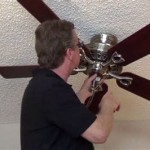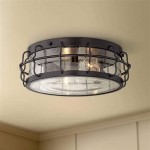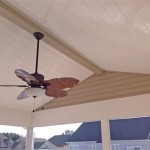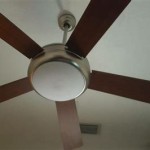What Size Ceiling Fan for a Large Living Room? A Comprehensive Guide
Selecting the appropriate ceiling fan size for a large living room is crucial for achieving optimal airflow, energy efficiency, and aesthetic harmony within the space. A fan that is too small will struggle to effectively circulate air, leading to stagnant areas and uncomfortable temperatures. Conversely, a fan that is excessively large can overwhelm the room, creating a disproportionate visual impact and potentially causing excessive noise or vibration. This article provides a comprehensive guide to determining the ideal ceiling fan size for large living rooms, considering factors such as room dimensions, blade pitch, and the impact of multiple fans.
The primary function of a ceiling fan is to move air, providing a cooling effect in the summer and assisting in heat distribution during the winter. In the summer, the downward airflow created by the fan helps evaporate moisture from the skin, creating a cooling sensation. In the winter, reversing the fan's direction allows it to gently push warm air that has risen to the ceiling back down into the living space. Effectively achieving both these functionalities requires careful consideration of fan size relative to the dimensions of the room.
Understanding the Importance of Room Size
The most significant factor influencing the appropriate ceiling fan size is the square footage of the living room. This measurement is obtained by multiplying the room's length by its width. The resulting value provides a basis for determining the required fan blade span. Common guidelines provide recommendations based on specific square footage ranges.
For rooms up to 75 square feet, a ceiling fan with a blade span of 36 inches or less is typically sufficient. For rooms between 76 and 144 square feet, a 42-inch fan is generally adequate. Rooms ranging from 144 to 225 square feet benefit from a 52-inch fan. However, for large living rooms exceeding 225 square feet, a 56-inch fan or larger is often necessary. For particularly expansive spaces, multiple ceiling fans may be the most effective solution.
Simply relying on square footage alone can be misleading. Room shape, ceiling height, and the presence of obstructions all play a role. For example, a long, narrow room may benefit from a different fan placement strategy than a square room with the same square footage. A room with high ceilings will require a downrod to properly position the fan blades for optimal airflow. Obstructions such as furniture or architectural features can impede airflow and may necessitate a larger fan or multiple fans to ensure adequate circulation throughout the entire space.
Ceiling height is a critical consideration that affects the effectiveness of a ceiling fan. Standard ceiling heights are typically around 8 to 9 feet. In these cases, a flush-mount or hugger-style fan can be suitable, especially if headroom is limited. However, for ceilings higher than 9 feet, a downrod is essential. A downrod is a metal extension that hangs the fan lower from the ceiling, positioning the blades closer to the occupants and maximizing airflow. The length of the downrod depends on the ceiling height. As a general rule, the fan blades should be at least 7 feet from the floor to ensure safety and optimal performance. For ceilings exceeding 10 feet, longer downrods are required to maintain this clearance.
Blade Pitch and Motor Performance
While blade span is a primary determinant of airflow, the blade pitch, which is the angle of the blades, significantly impacts the fan's effectiveness. A steeper blade pitch generally results in greater air movement, but it can also increase noise levels and energy consumption. A shallower blade pitch may be quieter and more energy-efficient, but it may not provide sufficient airflow for a large living room. A balance between these factors is crucial.
The motor is the heart of the ceiling fan, and its performance directly affects the fan's ability to move air efficiently. Motors are typically rated by their airflow capacity, measured in cubic feet per minute (CFM). A higher CFM rating indicates a more powerful motor capable of moving a larger volume of air. When selecting a ceiling fan for a large living room, it is essential to choose a fan with a motor that is powerful enough to effectively circulate air throughout the entire space. Factors such as motor type (AC vs. DC) and energy efficiency ratings should also be considered.
DC motors are generally more energy-efficient and quieter than AC motors. While fans with DC motors may come with a higher initial cost, they can save money over the long term due to reduced energy consumption. Additionally, DC motors often offer more speed settings and smoother operation than AC motors. Considering both the airflow capacity and the motor's efficiency is key to choosing a fan that provides optimal performance and cost savings.
The number of blades a ceiling fan possesses is often a matter of aesthetic preference, but it can also influence airflow and noise levels. While a larger number of blades might seem intuitively better for airflow, this is not always the case. Fans with fewer blades, but with a more aggressive blade pitch and a powerful motor, can often move more air than fans with more blades but less aggressive pitches. Furthermore, fans with fewer blades tend to be quieter. The key is to focus on the overall design and performance characteristics of the fan rather than solely on the number of blades.
Multiple Fans: A Viable Alternative
For exceptionally large living rooms, or those with irregular shapes, installing multiple ceiling fans can be a more effective solution than relying on a single, oversized fan. Multiple fans can distribute airflow more evenly throughout the space, eliminating stagnant areas and ensuring consistent temperatures. When considering multiple fans, it is important to strategically position them to maximize their combined effectiveness.
When opting for multiple fans, the size of each individual fan can be smaller than what would be required for a single fan solution. This can be beneficial in terms of aesthetics, as smaller fans may be less visually imposing in the room. The combined CFM of all the fans should be adequate to effectively circulate the air in the entire living room. Careful planning and placement are essential to ensure that the fans work together to create a comfortable and efficient environment.
Spacing between multiple ceiling fans should ideally be evenly distributed for effective air circulation. A good rule of thumb is to consider the range that each fan can effectively circulate air, and overlap those ranges. This will reduce pockets where air circulation is reduced. The exact distance depends on the CFM and blade size of the individual fans. Using fans with remote controls means that all fans can be operated individually or in unison, ensuring greater control of airflow.
When integrating multiple fans into a large living room, carefully consider the overall aesthetic. Selecting fans with a matching design and finish can create a cohesive and visually appealing look. Alternatively, using fans with different but complementary styles can add visual interest and personality to the space. Regardless of the design approach, it is essential to ensure that the fans complement the overall décor of the living room.
In addition to the aesthetic considerations and the overall size of the fans, it is important to ensure the electrical wiring in the room is capable of handling multiple fans. Consult with a qualified electrician to ensure that the wiring and circuit breakers are adequate to support the additional electrical load. This is particularly important if the fans will also include lighting fixtures. Failure to properly assess and address the electrical requirements can lead to safety hazards and operational issues.
Ultimately, determining the appropriate ceiling fan size for a large living room involves careful consideration of several factors, including room dimensions, ceiling height, blade pitch, motor performance, and the potential use of multiple fans. By taking these factors into account, homeowners can select a ceiling fan solution that provides optimal airflow, energy efficiency, and aesthetic appeal for their living space. By following this guidance and, if necessary, consulting with a qualified professional, it is possible to create a more comfortable and inviting living environment.

Ceiling Fan Size Guide Delmarfans Com

Ceiling Fan Size Guide Delmarfans Com

Ceiling Fan Size Recommendations For Your Room Living

Quick Guide A Ceiling Fan Ideas Advice Lamps Plus

Ceiling Fan Size Guide Delmarfans Com

What Size Ceiling Fan Do You Need For Your Room Dan S City Fans Parts Accessories

Ceiling Fan Size Guide Delmarfans Com

Pin By Mirko Powell On Fundamental Of Lighting Ceiling Fan Size Large Fans

Ceiling Fan Size Guide Delmarfans Com

Ceiling Fan Guide Sizes And Styles Lowe S
Related Posts








